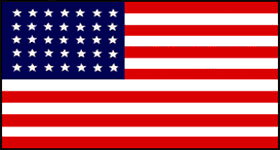 |
Civil War Battles |
|
State War Records |
| AL - AK - AZ - AR - CA - CO - CT - DE - FL - GA - HI - ID - IL - IN - IA - KS - KY - LA - MA - MD - ME - MI - MN - MS - MO - MT - NE - NV - NH - NJ - NM - NY - NC - ND - OH - OK - OR - PA - RI - SC - SD - TN - TX - UT - VT - VA - WA - WV - WI - WY |
The Battle of Fisher's Hill
September 21-22, 1864 in Shenandoah County, Virginia
 |
|||||||||||||
|
Maj. Gen. Philip H. Sheridan's Army of the Shenandoah achieved a signal victory at the Battle of Third Winchester on September 19th. The Federals sent Lt. Gen. Jubal A. Early's Army of the Valley "whirling through Winchester". During the night of the 19th, the Confederates retreated southward to Fisher's hill, 1 mile south of Strasburg and 21 miles from Winchester.
The veteran Confederates, members of Lt. Gen. Thoimas J. "Stonewall" Jackson's incomparable II Corps, filed into their old trenches on Fisher's Hill throughout the 20th. Early decided to make another stand there, the only place he could defend without opening the upper Shenandoah Valley to the Federals. Fisher's Hill was a high, steep bluff, seemingly heaved up by mistake from the valley floor during the Creation. Flanked by Massanutten Mountain on the east and Little North Mountain on the west, the eminence dominated the Shenandoah at its narrowest point. It had long been, a Union officer remarked, "the bugbear of the valley", a position, if adequately manned, that was nearly impregnable.
But with fewer than 9,000 effectives, the Confederate commander could not stretch his lines to make his works unassailable. he spread his troops even further by placing Brig. Gen. Lunsford L. Lomax's undermanned, demoralized cavalry command on his vulnerable left, where the high bluff sloped down into a small valley before merging with Little North Mountain. But Early's rugged fighters welcomed the stand. They wanted another chance at the Federals.
The jubilant Federals arrived before Fisher's hill late on the 20th. Sheridan had benn halted in August by the high bluff, and he knew the difficulties of a frontal attack. That night he met with his 3 infantry corps commanders-Maj. Gens. Horatio G. Wright, William H. Emory, and George Crook. Crook suggested using his command in a flanking maneuver similar to the one executed at winchester. Though Wright and Emory demurred, Sheridan approved the plan. As a secondary phase, Sheridan ordered his cavalry commander, Maj. Gen. Alfred T.A. Torbert, to take 2 divisions, sweep up the Luray valley, cross the Manassutten at New Market Gap, and cut Early's only avenue of retreat. Crook's attack was scheduled for the 22nd.
On the 21st, Sheridan drove Early’s outposts back so that he could fully examine the Confederate line. He decided to stake everything on the major flanking attack; he would commit one of his 3 corps to the west, and also 2/3 of the cavalry to the east. The 2 other corps did a brilliant job of feinting attacks, holding Early’s whole attention until 4:00 P.M. Then Crook’s 2 divisions smashed into the dismounted Confederate cavalry, troops Early considered his least reliable. They didn’t resist for long, and when they ran it exposed the flank of the infantry. Defeat spread down the Confederate line as each unit was outflanked from the west. As the Confederates fell into confusion, Sheridan’s infantry moved forward. He was at the forefront, egging the men on and trying to turn the Confederate defeat into a disaster.
His 2 cavalry divisions under Torbert achieved nothing because they met 2 Confederate brigades at a narrow pass. Rather than get involved in a risky and bloody battle Torbert paused. But the third cavalry division should have achieved more. Averell’s division was back with the main army and should have rounded up hundreds of retreating Confederates – except Averell decided not to risk anything in the dark and camped. Sheridan sacked him after one more chance, when Averell still wasn’t aggressive in pursuit of an obviously whipped enemy.
Early had little choice but to get as far away from Sheridan as he could. He’d lost over 1,200 men (mainly prisoners) and 16 guns, but his army was demoralized and not fit to fight. He retreated to Rockfish Gap in the Blue Ridge which preserved his army (Sheridan couldn’t use his superior numbers in the restricted terrain) but left the Valley wide open to a Union "scorched earth" policy. Sheridan’s orders had 2 parts: first was to beat the Confederate army, but second was to burn everything that would support another Confederate invasion. With Early out of the way, he got started. Mills and barns from Staunton to Strasburg went up in flames in “The Burning” or “Red October.”
Sheridan had completely routed the Confederate army, sending it toward the Blue Ridge Mountains and clearing the upper valley for his own troops. Though Torbert had failed to seal off the Confederate retreat, Sheridan had again won a crucial victory. His victories at Winchester and Fisher's Hill, within 4 days, provided Pres. Lincoln's re-election campaign with timely, sorely needed military successes. The twin Confederate defeats also marked the beginning of the end for the Confederacy in Virginia.
